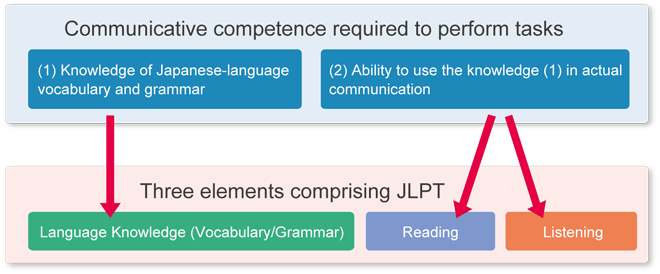Measures communicative competence required to perform tasks

The JLPT places importance not only on (1) knowledge of Japanese-language vocabulary and grammar but also on the (2) ability to use the knowledge in actual communication. In order to perform various "everyday tasks" that require language, not only language knowledge but also the ability to actually use it are necessary. Therefore, the JLPT measures comprehensive Japanese-language communicative competence through three elements: "Language Knowledge" to measure (1), and "Reading" and "Listening" to measure (2).

Due to the large scale of testing, answers will be machine-scored. Note that the JLPT does not include sections to measure speaking or writing proficiency directly.
Select a suitable level from among five levels

The JLPT is offered in five levels (N1, N2, N3, N4, N5). In order to measure Japanese-language proficiency as thoroughly as possible, test items are designed for each level.
N4 and N5 measure understanding of basic Japanese that is mainly learned in the classroom. N1 and N2 measure understanding of Japanese used in a broad range of actual everyday scenes. N3 bridges the gap between N4/N5 and N1/N2.
See "N1-N5: Summary of linguistic competence required for each level."
More accurately measures Japanese-language proficiency with scaled scores

Despite the best attempts to assure consistency, it is inevitable that the level of difficulty of the test will differ slightly from session to session. Using "raw scores" (based on the number of correct answers) could result in different test scores for individuals with the same ability, depending on the difficulty of tests. Instead of raw scores, the JLPT has adopted "scaled scores." Scaled scores are based on the equalization method and allow measurement on the same scale regardless of time the test is taken.
Scaled scores enable the JLPT to more accurately and fairly indicate Japanese-language ability at the time of testing.
See the more detailed explanation about scaled scores(PDF/71KB)
"JLPT Can-do Self-Evaluation List" is offered

Test scores and pass/fail results alone do not clarify what students can do in Japanese in real life.
For this reason, the JLPT offers "JLPT Can-do Self-Evaluation List" as a reference to interpret test results.
A question survey regarding "what activities are considered possible in Japanese" was conducted with approximately 65,000 examinees of the 2010 and 2011 JLPT. The results were analyzed and the list was prepared.
The list can be used by examinees and others as a reference to get an idea of "what successful examinees of a particular level can do in Japanese."
For more details on "JLPT Can-do Self-Evaluation List," please check here.

-
- *Outside Japan, the test may be held only in July or December in some cities. Click here for the test schedule in your city.
End of Text










